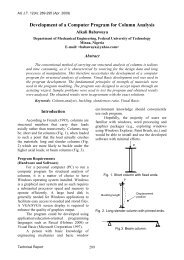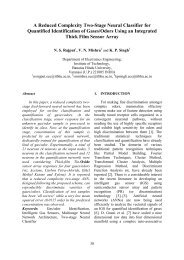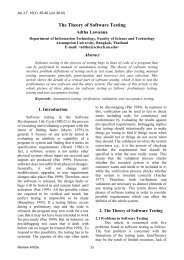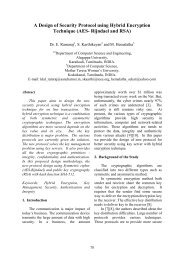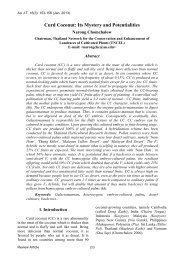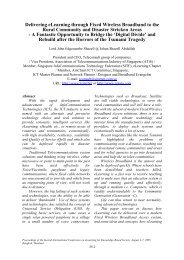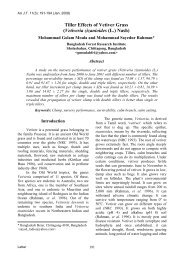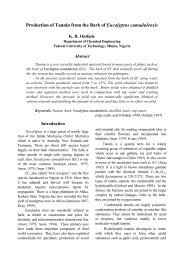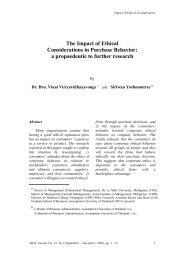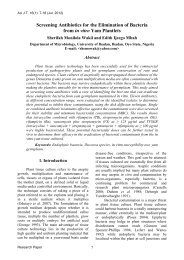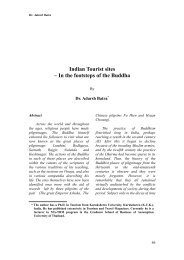An Ordeal Random Data Encryption Scheme (ORDES) - AU Journal
An Ordeal Random Data Encryption Scheme (ORDES) - AU Journal
An Ordeal Random Data Encryption Scheme (ORDES) - AU Journal
Create successful ePaper yourself
Turn your PDF publications into a flip-book with our unique Google optimized e-Paper software.
Ramveer Singh and Deo Brat Ojha<br />
<strong>An</strong> <strong>Ordeal</strong> <strong>Random</strong> <strong>Data</strong> <strong>Encryption</strong> <strong>Scheme</strong> (<strong>ORDES</strong>)<br />
1 Ramveer Singh<br />
2 Deo Brat Ojha<br />
1 (Research Scholar Singhania University, Jhunjhunu, Rajsthan)<br />
Department of Information Technology, Raj Kumar Goel Institute of Technology,<br />
5 th K.M. Stone Delhi – Meerut Road,Ghaziabad, U.P.201003, INDIA<br />
ramveersingh_rana@yahoo.co.in<br />
2 Professor, Department of Mathematics,Raj Kumar Goel Institute of Technology,<br />
5 th K.M. Stone Delhi – Meerut Road,Ghaziabad, U.P.201003,INDIA<br />
ojhdb@yahoo.co.in<br />
Abstract<br />
In this paper, authors presented a new<br />
<strong>Data</strong> encryption scheme named as <strong>Ordeal</strong><br />
<strong>Random</strong> <strong>Data</strong> <strong>Encryption</strong> <strong>Scheme</strong> (<strong>ORDES</strong>).<br />
The theoretical security measures are also<br />
discussed and <strong>ORDES</strong> advocates its<br />
competency .Through this paper, we<br />
encourage the user to use <strong>ORDES</strong> with more<br />
efficiency and security. Mainly we emphasis<br />
on secrecy of key because all knows key<br />
always play vital role in cryptography. Using<br />
a variable random number and a function,<br />
the new generated key for each block of<br />
message make this approach attractive and<br />
more usable. The portability and usability of<br />
key changes the state of affairs of DES in<br />
every block of structure. This approach<br />
<strong>ORDES</strong> motivates the user to use DES with<br />
new destiny of confidence, integrity and<br />
authentication.<br />
Keywords Cryptography, <strong>Data</strong><br />
<strong>Encryption</strong> Standard, <strong>Encryption</strong>,<br />
Decryption, Secret key, Hardware <strong>Random</strong><br />
Number Generator.<br />
I. INTRODUCTION<br />
<strong>Data</strong> <strong>Encryption</strong> Standard (DES)<br />
symmetric key cryptosystem, which was the<br />
natural choice, given that this cryptosystem<br />
had been around since 1976 and was the<br />
official symmetric encryption algorithm<br />
standardized by NIST and adopted by the US<br />
Government. Since DES is asymmetric key<br />
cryptosystem, it could only be used to<br />
achieve confidentiality.<br />
The <strong>Data</strong> <strong>Encryption</strong> Standard (DES)<br />
algorithm, adopted by the US government in<br />
1977, is the US government's secret-key data<br />
encryption standard and is widely used<br />
around the world in a variety applications<br />
including banking and wide-area networking<br />
applications. It is a block cipher that<br />
transforms 64-bit data blocks under a 56-bit<br />
secret key, by means of permutation and<br />
substitution. It encrypts a confidential<br />
message into scrambled output under the<br />
control of the secret key. The input message<br />
is also known as "plaintext" and the resulting<br />
output message as "ciphertext". The idea is<br />
that only recipients who know the secret key<br />
can decrypt the ciphertext to obtain the<br />
original message. DES uses a 56-bit key, so<br />
there are 256 possible keys [1].<br />
Due to its importance, DES has received<br />
a great deal of cryptanalytic attention.<br />
However, besides using the complementation<br />
property, there were no short-cut attacks<br />
against the cipher until differential<br />
cryptanalysis was applied to the full DES in<br />
1991 [2–4].<br />
In [5], Chaum and Evertse presented<br />
several meet-in-the-middle attacks on<br />
reduced variants of DES. They showed that<br />
the first six round of DES are susceptible to<br />
38
<strong>An</strong> <strong>Ordeal</strong> <strong>Random</strong> <strong>Data</strong> <strong>Encryption</strong> <strong>Scheme</strong> (<strong>ORDES</strong>)<br />
meet-in-the-middle attacks, such as rounds<br />
2–8. They also showed that their approach<br />
cannot be extended to more than seven<br />
rounds of DES.<br />
In 1987 Davies described a known<br />
plaintext attack on DES [6]. The attack<br />
obtains 16 linear equations of the key bits<br />
given sufficiently many known plain- texts<br />
by examining the bits that are shared by<br />
neighboring S-boxes. Davies’ on the full<br />
DES requires more plaintexts than the entire<br />
code book. For 8-round DES, the attack<br />
requires about 240 known plaintexts. In [7]<br />
these results were slightly improved but still<br />
could not attack the full DES faster than<br />
exhaustive key search. In 1994 Biham and<br />
Biryukov [8] improved the attack to be<br />
applicable to the full DES. Their variant of<br />
the attack requires 250 known plaintexts and<br />
has a running time of 249 encryptions on an<br />
average. A chosen ciphertext variant of the<br />
attack is presented in [9]; it has a data<br />
complexity of 245 chosen plaintexts. The<br />
first attack on DES that is faster than<br />
exhaustive key search was presented in [10].<br />
The attack, differential cryptanalysis,<br />
requires 247 chosen plaintexts. The attack<br />
examines pairs of plaintexts and ciphertexts,<br />
trying to find a pair that satisfies some<br />
differential. Once such a pair is found, the<br />
key can be deduced. In [11] another attack<br />
on DES is presented, linear cryptanalysis.<br />
The linear attack on DES uses 243 known<br />
plaintexts and deduces the key by checking<br />
whether some linear relation between the<br />
plaintext and the ciphertext is satisfied. This<br />
attack was later improved in [12] by<br />
exploiting nonlinear relations as well. The<br />
improved attack has a data complexity of<br />
242.6 known plaintexts. Using chosen<br />
plaintexts, Knudsen and Mathiassen reduced<br />
the data complexity in by a factor of 2.<br />
Even after DES was theoretically<br />
broken, it was claimed that DES was still<br />
secure, as it was not possible to mount these<br />
attacks in practice. As a response, RSA <strong>Data</strong><br />
Security Inc. has issued several “DES<br />
Challenges” during the mid ’90s. In each<br />
such challenge, RSA published a plaintext<br />
and its ciphertext encrypted using DES under<br />
some unknown key, and offered a prize of<br />
several thousand US dollars for whoever<br />
finds the secret key [13]. The first exhaustive<br />
key search took about 75 days and the key<br />
was found using 14,000–80,000 computers<br />
over the Internet [14]. Ever since, the time<br />
required for each new DES challenge has<br />
been reduced. In 1997 the Electronic Frontier<br />
Foundation (EFF) built a special purpose<br />
machine that costs 250,000 US dollars which<br />
retrieved the key in 56 hours by means of<br />
exhaustive key search [15]. With 16 known<br />
plaintext-ciphertext pairs, their techniques<br />
produce an equation system with 1080<br />
variables and 2048 non-linear equations from<br />
4- round DES. While their methods work on<br />
5 or more rounds of DES, they are too<br />
complex to be considered in practice. The<br />
approach of treating reduced-round DES as<br />
an algebraic equation was also suggested in<br />
[16].<br />
Motivation behind our work: Despite the<br />
well known weaknesses of DES, the cipher<br />
is still widely deployed and used. In addition,<br />
DES-like ciphers are being suggested as a<br />
solution for encryption in RFID systems<br />
[17]. All the existing attacks on DES either<br />
use a long time (exhaustive key search) or<br />
use a very large number of plaintexts. This<br />
motivated us to investigate how many rounds<br />
of DES can be broken using the meet-in-themiddle<br />
technique,<br />
using one (or very few) plaintexts. We<br />
aimed at finding the best attacks on reducedround<br />
DES. The results of this paper shed<br />
more light on the security of DES, leading to<br />
a better understanding on the way DES can<br />
be used [18]. The entire discussed articles<br />
describe the attack on DES, because DES<br />
has a single key to encrypt and decrypt to all<br />
blocks of message. After, study the entire<br />
journey of data encryption standard, now we<br />
are going to improve the vigour of key.<br />
International <strong>Journal</strong> of the Computer, the Internet and Management Vol.18.No.3 (September - December, 2010) pp 38-50<br />
39
Ramveer Singh and Deo Brat Ojha<br />
Contribution of this paper: This current<br />
article represent a new dimension in the field<br />
of cryptography with amplify the security of<br />
data encryption standard. In practical, data<br />
encryption standard is almost impossible to<br />
break. Due to the lack of security level<br />
possibility to break it, becomes easier. So,<br />
we went in search of suitable procedure to<br />
minimise the possibility of breaking security<br />
level, which certainly provides improvedness<br />
in DES. In our <strong>Ordeal</strong> <strong>Random</strong> <strong>Data</strong><br />
<strong>Encryption</strong> <strong>Scheme</strong>(<strong>ORDES</strong>) suggestion, we<br />
keen about the security of symmetric key<br />
which can provide us to further secure data.<br />
2. PRELIMINARIES<br />
<strong>Data</strong> encryption is the prominent role of<br />
cryptography process. On the prima facie<br />
status, we got two types of cryptography. In<br />
this manner of its classification:<br />
1. Classical Cryptography<br />
2. Modern Cryptography.<br />
The classical cryptography is based on<br />
the substitution and permutation and the<br />
modern cryptography is used various way to<br />
encrypt the message. In both classifications,<br />
unanimously key have pivotal role.<br />
The three most important objectives of<br />
cryptography with respect to the information<br />
security include-<br />
1. Confidentiality.<br />
2. <strong>Data</strong> integrity.<br />
3. Authentication [19].<br />
Confidentiality refers to the protection<br />
of information from unauthorized access. <strong>An</strong><br />
undesired communicating party, called<br />
adversary must not be able to access the<br />
communication material.<br />
<strong>Data</strong> integrity ensures that information<br />
has not been manipulated in an unauthorized<br />
way.<br />
Authentication methods are studied in<br />
two groups: Entity authentication and<br />
message authentication. Message<br />
authentication provides assurance of the<br />
identity of the sender of a message. This type<br />
of authentication also includes an evidence<br />
of data integrity because if the is modified<br />
during transmission, the sender cannot be the<br />
originator of the message. Entity<br />
authentication assures the receiver of a<br />
message of both the identity of the sender<br />
and his active participation.<br />
Modern cryptographic techniques<br />
provide solutions for these three objectives.<br />
In general, there are two types of<br />
cryptosystems:<br />
1. Symmetric (private) key cryptosystems.<br />
2. Asymmetric (public) key cryptosystems.<br />
2.1 Symmetric key cryptosystems<br />
All classical cryptosystems (that is<br />
cryptosystems that were developed before<br />
1970s) are examples of symmetric key<br />
cryptosystems. In addition, most modern<br />
cryptosystems are symmetric as well. Some<br />
of the most popular examples of modern<br />
symmetric key cryptosystems include AES<br />
(Advanced <strong>Encryption</strong> Standard), DES (<strong>Data</strong><br />
<strong>Encryption</strong> Standard), IDEA, FEAL, RC5,<br />
and many others. All symmetric key<br />
cryptosystems have a common property: they<br />
rely on a shared secret between<br />
communicating parties. This secret is used<br />
both as an encryption key and as a<br />
decryption key (thus the keyword<br />
"symmetric" in the name). This type of<br />
cryptography ensures only confidentiality<br />
and fails to provide the other objectives of<br />
cryptography. Even more importantly the<br />
disadvantage of symmetric key cryptography<br />
is that it cannot handle large communication<br />
networks. If a node in a communication<br />
network of n nodes needs to communicate<br />
confidentially with all other nodes in the<br />
network, it needs n - 1 shared secrets. For<br />
large value of n this is highly impractical and<br />
inconvenient. On the other hand, an<br />
advantage over public key cryptosystems is<br />
40
<strong>An</strong> <strong>Ordeal</strong> <strong>Random</strong> <strong>Data</strong> <strong>Encryption</strong> <strong>Scheme</strong> (<strong>ORDES</strong>)<br />
that symmetric cryptosystems require much<br />
smaller key sizes for the same level of<br />
security. Hence, the computations are much<br />
faster and the memory requirements are<br />
smaller [20].<br />
2.2 Public key cryptosystems<br />
In public key cryptosystems there are<br />
two different keys: a public key, which is<br />
publicly known, and the secret key, which is<br />
kept secret by the owner. The system is<br />
called “asymmetric” since the different keys<br />
are used for encryption and decryption– the<br />
public key and the private key. If data is<br />
encrypted with a public key, it can only be<br />
decrypted using the corresponding private<br />
key, and vice versa. Today, all public key<br />
cryptosystems rely on some computationally<br />
intractable problems. For example, the<br />
cryptosystem RSA relies on the difficulty of<br />
factoring large integers, while El-Gamal<br />
cryptosystem relies on the discrete logarithm<br />
problem (DLP), which is the problem of<br />
finding a logarithm of a group element with<br />
generator base in a finite Abelian group<br />
Public key cryptosystems do not need to<br />
have a shared secret between communicating<br />
parties. This solves the problem of large<br />
confidential communication network<br />
introduced earlier. In addition, public key<br />
cryptography opened door for ways of<br />
implementing technologies to ensure all<br />
goals of cryptography. By means of<br />
combining public key cryptography, public<br />
key certification, and secure hash functions,<br />
there are protocols that enable digital<br />
signatures, authentication, and data integrity.<br />
Due to the increase in processor speed and<br />
even more due to smart modern<br />
cryptanalysis, the key size for public key<br />
cryptography grew very large. This created a<br />
disadvantage in comparison to symmetric<br />
key cryptosystems: public key cryptography<br />
is significantly slower, and requires large<br />
memory capacity and large computational<br />
power. As an example, a 128-bit key used<br />
with DES cryptosystem has approximately<br />
the same level of security as the 1024-bit key<br />
used with RSA public key cryptosystem<br />
[21].<br />
2.3 <strong>Data</strong> <strong>Encryption</strong> Standard (DES)<br />
DES relies upon the encryption<br />
techniques of confusion and diffusion.<br />
Confusion is accomplished through<br />
substitution. Specially chosen sections of<br />
data are substituted for corresponding<br />
sections from the original data. The choice of<br />
the substituted data is based upon the key<br />
and the original plaintext. Diffusion is<br />
accomplished through permutation. The data<br />
is permuted by rearranging the order of the<br />
various sections. These permutations, like<br />
the substitutions, are based upon the key and<br />
the original plaintext. The substitutions and<br />
permutations are specified by the DES<br />
algorithm. Chosen sections of the key and<br />
the data are manipulated mathematically and<br />
then used as the input to a look-up table. In<br />
DES these tables are called the S-boxes and<br />
the P-boxes, for the substitution tables and<br />
the permutation tables, respectively. Usually<br />
the S- and P-boxes are combined so that the<br />
substitution and following permutation for<br />
each round can be done with a single lookup.<br />
In order to calculate the inputs to the S-<br />
and P-box arrays, portions of the data are<br />
XORed with portions of the key. One of the<br />
32-bit halves of the 64-bit data and the 56-bit<br />
key are used. Because the key is longer than<br />
the data half, the 32-bit data half is sent<br />
through an expansion permutation which<br />
rearranges its bits, repeating certain bits, to<br />
form a 48-bit product. Similarly the 56-bit<br />
key undergoes a compression permutation<br />
which rearranges its bits, discarding certain<br />
bits, to form a 48-bit product. The Sand P-<br />
box look-ups and the calculations upon the<br />
key and data which generate the inputs to<br />
these table look-ups constitute a single round<br />
of DES.<br />
International <strong>Journal</strong> of the Computer, the Internet and Management Vol.18.No.3 (September - December, 2010) pp 38-50<br />
41
Ramveer Singh and Deo Brat Ojha<br />
This same process of S- and P-box<br />
substitution and permutation is repeated<br />
sixteen times, forming the sixteen rounds of<br />
the DES algorithm (see Fig. 1(a)). There are<br />
also initial and final permutations which<br />
occur before and after the sixteen rounds.<br />
Fig. 1(a) DES Core Algorithm (b) Single<br />
Round Expanded<br />
These initial and final permutations exist<br />
for historical reasons dealing with<br />
implementation on hardware and do not<br />
improve the security of the algorithm. For<br />
this reason they are sometimes left out of<br />
implementations of DES. They are, however,<br />
included in this analysis as they are part of<br />
the technical definition of DES [22].<br />
2.4 Triple <strong>Data</strong> <strong>Encryption</strong> Algorithm<br />
Let EK (P.T.) and DK (P.T.) represent<br />
the DES encryption and decryption of Plain<br />
Text using DES key K respectively. Each<br />
TDEA encryption/decryption operation is a<br />
compound operation of DES encryption and<br />
decryption operations. The following<br />
operations are used:<br />
• TDEA encryption operation:<br />
The transformation of a 64-bit block<br />
P.T. into a 64-bit block C.T. that is defined<br />
as follows: C.T = EK3 (DK2 (EK1 (P.T.))).<br />
• TDEA decryption operation:<br />
The transformation of a 64-bit block P.T<br />
into a 64-bit block C.T. that is defined as<br />
follows: C.T. = DK1 (EK2 (DK3 (P.T.))).<br />
The standard specifies the following<br />
keying options for bundle (K1, K2, K3).<br />
Keying Option 1:<br />
K1, K2 and K3 are independent keys.<br />
Keying Option 2:<br />
K1 and K2 are independent keys and K3 =<br />
K1.<br />
Keying Option 3:<br />
K1 = K2 = K3.<br />
A TDEA mode of operation is backward<br />
compatible with its single DES counterpart<br />
if, with compatible keying options for TDEA<br />
operation,<br />
• <strong>An</strong> encrypted plaintext computed<br />
using a single DES mode of operation can be<br />
decrypted correctly by a corresponding<br />
TDEA mode of operation; and<br />
• <strong>An</strong> encrypted plaintext computed<br />
using a TDEA mode of operation can be<br />
decrypted correctly by a corresponding<br />
single DES mode of operation [23].<br />
2.5 Cryptanalysis<br />
Cryptanalysis is an art of deciphering<br />
an encrypted message in whole or in part,<br />
when the decryption key is not known.<br />
Depending on the amount of known<br />
information and the amount of control over<br />
the system by the adversary (cryptanalyst),<br />
there are several basic types of cryptanalytic<br />
attacks [23, 24, 25, 26, 27, 28].<br />
Ciphertext-only attack: The adversary<br />
only has access to one or more encrypted<br />
messages. The most important goal of a<br />
proposed cryptosystem is to withstand this<br />
type of attack.<br />
Brute force attack: This is a type of<br />
ciphertext-only attack. It is based on<br />
exhaustive key search, and for well-designed<br />
cryptosystems should be computationally<br />
infeasible. By today’s standards, 128-bit<br />
42
<strong>An</strong> <strong>Ordeal</strong> <strong>Random</strong> <strong>Data</strong> <strong>Encryption</strong> <strong>Scheme</strong> (<strong>ORDES</strong>)<br />
keys are considered secure against the brute<br />
force attack.<br />
Known-plaintext attack: In this type of<br />
attack an adversary has some knowledge<br />
about the plaintext corresponding to the<br />
given ciphertext. This may help determine<br />
the key or a part of the key.<br />
Chosen-plaintext attack: Essentially, an<br />
adversary can feed the chosen plaintext into<br />
the black box that contains the encryption<br />
algorithm and the encryption key. The black<br />
box spits out the corresponding ciphertext,<br />
and the adversary may use the accumulated<br />
knowledge about the plaintext-ciphertext<br />
pairs to obtain the secret key or at least a part<br />
of it [29].<br />
Chosen-ciphertext attack: Here, an<br />
adversary can feed the chosen ciphertext into<br />
the black box that contains the decryption<br />
algorithm and the decryption key. The black<br />
box produces the corresponding plaintext,<br />
and the adversary tries to obtain the secret<br />
key or a part of the key by analyzing the<br />
accumulated ciphertext-plaintext pairs.<br />
2.6 <strong>Random</strong> Number Generator<br />
<strong>Random</strong> numbers are essential<br />
ingredients in a great number of solutions in<br />
computer Science. However, one of the most<br />
important uses of random numbers comes<br />
from cryptographic computer security<br />
protocols and algorithms. Cryptographic<br />
applications use random numbers to generate<br />
encryption keys, create initial parameter<br />
values, and to introduce random nonces into<br />
protocols and padding schemes. In most<br />
cases these random numbers come from a<br />
Pseudorandom Number Generator (PRNG)<br />
which is a deterministic software algorithm<br />
which imitates randomness. A PRNG takes<br />
an input string of bits, or a bit vector, and<br />
generates a longer output bit-vector which<br />
“appears” random. Although there are many<br />
definitions of what it means for a bit-vector<br />
to “appear” random, one general rule<br />
requires that a pseudorandom number is<br />
indistinguishable from a “truly” random<br />
number. That is, given a random number and<br />
a pseudorandom number, it is<br />
computationally intractable to execute an<br />
algorithm which could identify the<br />
pseudorandom number. This is related to<br />
another important criterion which requires<br />
that every “next” output bit from the random<br />
number generator must be unpredictable or<br />
uncorrelated to all prior bits. While many<br />
pseudorandom number generators exist, not<br />
all of them satisfy the indistinguishability<br />
requirement and are therefore not<br />
cryptographically sound. For example, the<br />
ISO C rand() function would not create<br />
“good” cryptographic keys. It can be shown,<br />
however, that any candidate one-way<br />
function can be used directly as<br />
pseudorandom number generator that is<br />
cryptographically sound. Therefore,<br />
algorithms such as SHA-1 or RSA<br />
Laboratories’ BSAFE are commonly used as<br />
a PRNG.<br />
Unfortunately, PRNGs suffer from two<br />
major security disadvantages. First, PRNGs<br />
require some input which deterministically<br />
governs the output. To securely use a PRNG,<br />
this input (the “seed”) must be kept secret.<br />
Second, PRNGs can only generate fixed<br />
number bits before they cycle and repeat<br />
themselves. For applications that require<br />
extremely long periods of random bits this<br />
can be a problem. Hardware random number<br />
generators (HRNG) do not suffer from these<br />
two issues since they generate aperiodic<br />
“random” output without the need of input.<br />
To do this they generate output bits by<br />
exploiting inherent unpredictability in<br />
complex physical systems and processes.<br />
Because of this, the security of any HRNG is<br />
directly tied to the infeasibility of modeling<br />
and imitating the underlying physical<br />
system. Although hardware generators are<br />
quite difficult to design, and even more<br />
difficult to validate, a number of candidate<br />
HRNG designs have been developed [30, 31,<br />
32, 33,].<br />
International <strong>Journal</strong> of the Computer, the Internet and Management Vol.18.No.3 (September - December, 2010) pp 38-50<br />
43
Ramveer Singh and Deo Brat Ojha<br />
3. OUR APPROACH<br />
In this approach, we encourage the user<br />
to use data encryption standard with more<br />
efficiency and security. Mainly we emphasis<br />
on secrecy of key because all knows key<br />
always play vital role in cryptography. As<br />
traditional DES, the key block size is 56 bit<br />
and data block size 64 bit, DES follows the<br />
block cipher mode encryption and<br />
decryption.<br />
In this article, we make various keys<br />
applying a function F on random number and<br />
initial 56 bit secret key. This new made keys<br />
work as a secret key in <strong>Data</strong> <strong>Encryption</strong><br />
Standard for each block of message.<br />
In Traditional DES:<br />
M = {m1, m2, m3, ........................................,<br />
mn} (64- bit block of message)<br />
K = {K} (56- bit Key)<br />
Key Generation:<br />
Fig. 2. Shows the key generation process for<br />
each round of DES.<br />
As per traditional DES, <strong>Encryption</strong> process<br />
follows the feistel structure (16- round) and<br />
make a new key for each round by the<br />
permutation on bits of key k as shown in fig.<br />
2. Same key k applies on each block of<br />
message m using shifting property for<br />
encryption and decryption through DES.<br />
<strong>ORDES</strong> Approach:<br />
We also using the same feistel structure<br />
and same process for encryption and<br />
decryption but we add a new process for key<br />
generation. In this process, key itself<br />
generate n different keys using a function<br />
and random number generated by Hardware<br />
<strong>Random</strong> Number Generator (HRNG) then<br />
new generated key block applies on the each<br />
block of message for all round of DES. For<br />
each block of message, the process generates<br />
a separate key. This new generated key used<br />
in encryption phase as well as the decryption<br />
phase.<br />
M={m1,m2,m3, ................................, mn}<br />
(64- bit block of message)<br />
K = {K} (56- bit Key)<br />
Key Generation:<br />
F {K and Rj} = K_new (x_p)<br />
Where Rj generated by Hardware <strong>Random</strong><br />
Number Generator (HRNG)<br />
and<br />
[1 ≤ Rj ≤ (256 = 72,057,594,037,927,936)].<br />
K_new (x_p) = K_new (x_1) to K_new<br />
(x_n)<br />
Fig. 2. Key generation Process for 16-<br />
Round of DES.<br />
For <strong>Encryption</strong>/Decryption:<br />
Ci = EK {mi}<br />
Cipher Text C = {C1, C2, ..............., Cn}<br />
and<br />
mi = DK {Ci}<br />
Plain Text M = {m1, m2, ................, mn}<br />
Figure 3: Process of new generated key of<br />
<strong>ORDES</strong><br />
44
<strong>An</strong> <strong>Ordeal</strong> <strong>Random</strong> <strong>Data</strong> <strong>Encryption</strong> <strong>Scheme</strong> (<strong>ORDES</strong>)<br />
Function F:<br />
Step 1- Input the bit value of initial key K<br />
(56-bit).<br />
Step 2- Input generated random number Rj ,<br />
generated by HRNG*.<br />
(*HRNG Property- 256 no., random<br />
number generator)<br />
Step 3- Convert Rj into 56- bit binary<br />
number.<br />
Step 4- Now, we have<br />
Key K = {KB1, KB2, KB3,<br />
........................., KB56}<br />
<strong>An</strong>d Rj ={Rb1, Rb2, Rb3,<br />
............................, Rb56}<br />
Where KBr is the bit of Key and Rbr is the<br />
bit of <strong>Random</strong> no. Here r =1, 2,<br />
3...............56.<br />
Step 5- Apply condition on K and Rj.<br />
IF Rbr = 1 then, Complement (convert 1 to<br />
1 or 0 to 0) of corresponding KBr.<br />
ANDIF Rbr = 0 then, Retain the same (1 to<br />
1 or 0 to 0) of corresponding KBr.<br />
Step 6- K_new (x_p) = Result of step 5.<br />
Using this function F every time we get the<br />
result K_new (x_p) for each block of<br />
message. For each block of M we generate a<br />
new no. Rj and implement function F.<br />
Finally get a new key for every block of<br />
message.<br />
For <strong>Encryption</strong>/Decryption:<br />
In encryption phase, <strong>ORDES</strong> take a message<br />
block mn and a new generated key K_new<br />
(x_p), implement encryption process as per<br />
traditional DES. One special thing make aur<br />
process is different- REKEYING PROCESS.<br />
REKEYING PROCESS have the property to<br />
make various key for various block of<br />
message.<br />
Now, we have a new key for every block of<br />
message. This new key K_new (x_p) is<br />
apply on each block of message M.<br />
In this process, New key is also make 16<br />
different key for every round of DES using<br />
shifting property as per traditional DES. For<br />
every block of message M, new key K_new<br />
(x_p) makes a new key block for every<br />
round of DES to implement in the encryption<br />
process.<br />
Decryption Process is the inverse step of<br />
encryption process. In decryption, we also<br />
use the same key which is used in<br />
encryption.<br />
Ci = E_(K_new (x_p)) {mi} and mi =<br />
D_(K_new (x_p)) {Ci}, where 1≤ i ≤ n.<br />
Cipher Text C = {C1, C2, ..........., Cn}<br />
and<br />
Plain Text M = {m1, m2, ..........., mn}.<br />
4. SECURITY ANALYSIS OF <strong>ORDES</strong><br />
In modern cryptography, <strong>Encryption</strong>/<br />
Decryption process based on the key. The<br />
strength of key shows that the strongness of<br />
scheme. In various cryptosystem (symmetric<br />
& asymmetric) have tedious way to find out<br />
the key.<br />
The basic concern related to security of<br />
key are:<br />
1. No sharing.<br />
2. No transfer.<br />
Benjamin Franklin says “Three people can<br />
keep a secret if two of them are dead”. This<br />
statement describes itself the major security<br />
of key is no sharing.<br />
Cryptographic scheme strength is often<br />
described by the bit length of encryption key.<br />
The more bits in the key, the harder it is to<br />
decrypt data simply by all possible key. DES<br />
uses 56 bit, Cracking 56- bit algorithm with a<br />
single key search might take around a week<br />
on a very powerful computer.<br />
International <strong>Journal</strong> of the Computer, the Internet and Management Vol.18.No.3 (September - December, 2010) pp 38-50<br />
45
Ramveer Singh and Deo Brat Ojha<br />
Initial Key<br />
K<br />
, ..........,<br />
M=m1, m2, m3, ................................................................................,m<br />
....................................<br />
m 1<br />
m 2<br />
Round<br />
1<br />
Round<br />
1<br />
Round<br />
1<br />
m n<br />
<strong>Data</strong> <strong>Encryption</strong> Standard<br />
.. Round ....... Round 16<br />
… ....<br />
<strong>Data</strong> <strong>Encryption</strong> Standard<br />
... Round .... Round 16<br />
. ....<br />
...<br />
<strong>Data</strong> <strong>Encryption</strong> Standard<br />
.... Round .... Round 16<br />
.... ....<br />
C= C1, C2, C3, ....................................................................................,Cn<br />
Fig. 4. Complete <strong>Encryption</strong> Process of <strong>ORDES</strong><br />
46
<strong>An</strong> <strong>Ordeal</strong> <strong>Random</strong> <strong>Data</strong> <strong>Encryption</strong> <strong>Scheme</strong> (<strong>ORDES</strong>)<br />
Now,<br />
At time t, the generated key<br />
is ,<br />
At time t + 1, the generated key is<br />
,<br />
<strong>An</strong>d At time t + n, the generated key is<br />
Here,<br />
≠<br />
It might be possible that,<br />
, , , are equal if<br />
and only if the generated no. Rj at time t, t +<br />
1, t + n are same, But the probability of<br />
generate the same no. at different time is<br />
very much low because of we are using<br />
HRNG.<br />
Now, Compare with traditional DES, we<br />
simply analyze the security level of <strong>ORDES</strong>.<br />
If message have n blocks then the security of<br />
<strong>ORDES</strong> is increase n times more than<br />
traditional DES. We also accept that the<br />
process might be face one problem –<br />
Increase the overhead. But due to aspect of<br />
security level, we can compromise with that<br />
problem.<br />
Meet-in-the-Middle Attacks:<br />
Meet-in-the-middle can minimise the<br />
number of brute force permutations required<br />
to decrypt message that has been encrypted<br />
by more than one key. This attack<br />
targets block cipher cryptographic schemes.<br />
The attackers apply brute force technique to<br />
both the plaintext and ciphertext of a block<br />
cipher. He then attempts to encrypt the<br />
plaintext according to various possible<br />
combinations of keys to achieve an<br />
intermediate ciphertext (a text that has only<br />
been encrypted by one key). Simultaneously,<br />
he attempts to decrypt the ciphertext<br />
according to various possible combinations<br />
of keys, seeking a block of intermediate<br />
ciphertext that is the same as the one<br />
achieved by encrypting the plaintext. If there<br />
is a match of intermediate ciphertext, it is<br />
highly probable that the key used to encrypt<br />
the plaintext and the key used to decrypt the<br />
ciphertext are the two encryption keys used<br />
for the block cipher.<br />
Remark: <strong>ORDES</strong> successfully meet with<br />
this requirement.<br />
Linear Factors:<br />
DES consist a plaintext, a key size, a<br />
ciphertext and a family of invertible maps<br />
indexed by the key space. We say that<br />
cryptosystem X is a factor of cryptosystem Y<br />
if there are maps (called factor maps)<br />
between the plaintext, key and ciphertext<br />
such that the enciphering and deciphering<br />
action of cryptosystem A can be recovered<br />
from those of cryptosystem B using factor of<br />
B. If the key space of A is smaller than that<br />
of B one can profitably break B by first<br />
breaking A.<br />
Remark: <strong>ORDES</strong> successfully meet with<br />
this requirement.<br />
Weak Keys:<br />
A weak key ‘K’ is a key for which<br />
encryption is the same function as<br />
decryption. A pair of semi-weak keys, K and<br />
K’, are keys for which encryption with K is<br />
the same as decryption with K’ and vice<br />
versa. DES has weak keys, if the number of<br />
weak keys is relatively small, they may not<br />
compromise the cipher when used to assure<br />
confidentiality.<br />
Remark: <strong>ORDES</strong> successfully meet with<br />
this requirement.<br />
Detectable Key Classes:<br />
One way to reduce the effective<br />
keyspace is to divide the keyspace into<br />
classes, and then find an attack that reveals<br />
to which class the key belongs. In some<br />
instances, the workload of identifying a key<br />
with a specific class is very small; these too<br />
are sometimes referred to as weak keys.<br />
IDEA has several classes of keys detectable<br />
with just two chosen-plaintext encryptions.<br />
The key schedule allows two different keys<br />
to have several round keys in common; this<br />
reduces the affective keyspace by almost a<br />
factor of four using 233chosen plaintexts.<br />
International <strong>Journal</strong> of the Computer, the Internet and Management Vol.18.No.3 (September - December, 2010) pp 38-50<br />
47
Ramveer Singh and Deo Brat Ojha<br />
Due to the weak mixing in its key schedule,<br />
RC4 has a class of detectable keys. One out<br />
of 256 keys is detectable, and a detectable<br />
key has about a 13.8% chance of revealing<br />
16 bits of the key in the first output byte.<br />
Remark: <strong>ORDES</strong> successfully meet with<br />
this requirement.<br />
Simple Relations and Equivalent Keys:<br />
A simple relation occurs between two<br />
different keys, manifesting itself as a<br />
relationship between the resulting plaintexts<br />
and ciphertexts. This also allows the<br />
keyspace to be reduced in a search. DES has<br />
a simple relation known as the<br />
complementation property: if K encrypts P to<br />
C, then the bitwise complement of K<br />
encrypts the bitwise complement of P to the<br />
bitwise complement of C. This reduces the<br />
effective keyspace by one bit. DES has pairs<br />
of keys for which a simple relation exists, for<br />
at least a fraction of all plaintexts.<br />
Two keys are equivalent if they<br />
transform all plaintexts identically. This can<br />
be considered a special kind of simple<br />
relation.<br />
Remark: <strong>ORDES</strong> successfully meet with<br />
this requirement.<br />
Attacks on One-Wayness:<br />
A key schedule is one-way if, given<br />
several round subkeys, it is infeasible for an<br />
attacker to gain any new information about<br />
the master key or about other unknown<br />
round subkeys. For instance, recovering a<br />
few round subkeys allows one to recover<br />
most of the master key in the DES key<br />
schedule. Furthermore, it may be easier to<br />
find weak keys and related keys for key<br />
schedules which are not one-way.<br />
Remark: <strong>ORDES</strong> successfully meet with<br />
this requirement.<br />
Related Key Attack:<br />
A related-key attack is one where the<br />
attacker learns the encryption of certain<br />
plaintext not only under the original<br />
(unknown) key K, but also under some<br />
derived keys K’= f (K). In a chosen-relatedkey<br />
attack, the attacker specifies how the key<br />
is to be changed; known-related-key attacks<br />
are those where the key difference is known<br />
but cannot be chosen by the attacker. We<br />
emphasize that the attacker knows or<br />
chooses the relationship between keys, but<br />
not the actual key values.<br />
Three-key triple-DES is a well-known<br />
method for strengthening DES with a 168-bit<br />
key; it is also vulnerable to related-key<br />
attacks. This mode can be considered a 3-<br />
round cipher with independent 56-bit round<br />
subkeys, realizing that each round is very<br />
strong. Quixotically, one might use rotational<br />
related-key cryptanalysis; however, such an<br />
approach would require many known<br />
plaintexts.<br />
Remark: <strong>ORDES</strong> successfully meet with<br />
this requirement.<br />
5. CONCLUSION<br />
Our section 4 completely advocates the<br />
plausibility of <strong>ORDES</strong>. It is successful and<br />
needful for current communication scenario<br />
Case I<br />
If we take one and only one Key on the<br />
place of n keys then is K, At this<br />
condition our approach works like DES.<br />
Case II<br />
If = =<br />
than our approach also works like DES.<br />
References<br />
[1] <strong>Data</strong> <strong>Encryption</strong> Standard, Federal<br />
Information Processing Standards<br />
Publication (FIPS PUB) 46, National<br />
Bureau of Standards, Washington, DC<br />
(1977).<br />
[2] Eli Biham, Adi Shamir (1991),<br />
“Differential Cryptanalysis of DES-like<br />
48
<strong>An</strong> <strong>Ordeal</strong> <strong>Random</strong> <strong>Data</strong> <strong>Encryption</strong> <strong>Scheme</strong> (<strong>ORDES</strong>)<br />
Cryptosystems”, <strong>Journal</strong> of Cryptology,<br />
Vol. 4 No. 1, Springer, pp. 3–72.<br />
[3]. Eli Biham, Adi Shamir (1993),<br />
“Differential Cryptanalysis of the Full<br />
16-Round DES, Advances in<br />
Cryptology”, proceedings of CRYPTO<br />
’92, Lecture Notes in Computer Science<br />
740, Springer.<br />
[4]. Eli Biham, Adi Shamir (1993),<br />
Differential Cryptanalysis of the <strong>Data</strong><br />
<strong>Encryption</strong> Standard, Springer.<br />
[5]. David Chaum, Jan-Hendrik Evertse<br />
(1986), “Cryptanalysis of DES with a<br />
Reduced Number of Rounds: Sequences<br />
of Linear Factors in Block Ciphers”,<br />
Advances in Cryptology, proceedings of<br />
CRYPTO ’85, Lecture Notes in<br />
Computer Science 218, pp. 192–211,<br />
Springer.<br />
[6]. Donald W. Davies (1987), Investigation<br />
of a Potential Weakness in the DES<br />
Algorithm, private communications.<br />
[7] Donald W. Davies, Sean Murphy (1995),<br />
“Pairs and Triplets of DES S-Boxes”,<br />
<strong>Journal</strong> of Cryptology, Vol. 8, No. 1,<br />
pp. 1–25, Springer.<br />
[8]. Eli Biham, Alex Biryukov (1997), “<strong>An</strong><br />
Improvement of Davies’ Attack on<br />
DES”, <strong>Journal</strong> of Cryptology, Vol. 10,<br />
No. 3, pp. 195–206, Springer.<br />
[9] Sebastien Kunz-Jacques, Frederic Muller<br />
(2005), “New Improvements of Davies-<br />
Murphy Cryptanalysis”, Advances in<br />
Cryptology, proceedings of ASIACRYPT<br />
2005, Lecture Notes in Computer<br />
Science 3788, pp. 425–442, Springer.<br />
[10] Kunz-Jacques, S., Muller, F.(2005):<br />
“New Improvements of Davies-Murphy<br />
Cryptanalysis”. In: Roy, B. (ed.)<br />
ASIACRYPT 2005. LNCS, vol. 3788, pp.<br />
425–442. Springer, Heidelberg<br />
[11] Mitsuru Matsui (1994), “Linear Cryptanalysis<br />
Method for DES Cipher”,<br />
Advances in Cryptology, proceedings of<br />
EUROCRYPT ’93, Lecture Notes in<br />
Computer Science 765, pp. 386–397,<br />
Springer.<br />
[12] Takeshi Shimoyama, Toshinobu<br />
Kaneko (1998), “Quadratic Relation of<br />
S-box and Its Application to the Linear<br />
Attack of Full Round DES”, Advances<br />
in Cryptology, proceedings of CRYPTO<br />
’98, Lecture Notes in Computer Science<br />
1462, pp. 200–211, Springer.<br />
[13] CNET News.com, Users take crack at<br />
56-bit crypto. Available on-line at<br />
http://news.com.com/2100-1023-<br />
278658.html?legacy=cnet, 1997.<br />
[14]RSA <strong>Data</strong> Security, Team of<br />
Universities, Companies and Individual<br />
Computer Users Linked over the<br />
Internet Crack RSA’s 56-Bit DES<br />
Challenge. Available on-line at:<br />
http://www.rsasecurity.com/news/pr/970<br />
619-1.html, 1997.<br />
[15]Electronic Frontier Foundation,<br />
Cracking DES, Secrets of <strong>Encryption</strong><br />
Research, Wiretap Politics & Chip<br />
Design, O’reilly, 1998.<br />
[16]. Nicolas T. Courtois, Gregory V. Bard<br />
(2006), Algebraic Cryptanalysis of the<br />
<strong>Data</strong> <strong>Encryption</strong> Standard. Available<br />
on-line at: http://eprint.iacr.org/<br />
2006/402.pdf.<br />
[17] Axel Poschmann, Gregor Leander, Kai<br />
Schramm, Christof Paar (2007), “New<br />
Light-Weight DES Variants Suited for<br />
RFID Applications”, proceedings of<br />
Fast Software <strong>Encryption</strong> 14, Lecture<br />
Notes in Computer Science, Springer (to<br />
appear).<br />
[18] Orr Dunkelman, Gautham Sekar, and<br />
Bart Preneel (2007): “Improved Meetin-the-Middle<br />
Attacks on Reduced-<br />
Round DES”, to appear in Indocrypt.<br />
[19] A.M. Eskicioglu (2003), “Protecting<br />
Intellectual Property in Digital<br />
Multimedia Networks,” IEEE<br />
Computer, July, pp. 39-45.<br />
[20] Whitfield Diffie and Martin E. Hellman,<br />
“New Directions in Cryptography”<br />
IEEE transactions on Information<br />
Theory, 22, 644-654<br />
International <strong>Journal</strong> of the Computer, the Internet and Management Vol.18.No.3 (September - December, 2010) pp 38-50<br />
49
Ramveer Singh and Deo Brat Ojha<br />
[21] P.C. van Oorschot, A.J. Menezes, and<br />
S.A. Vanstone (1997), “Handbook of<br />
Applied Cryptography,” CRC Press,<br />
Inc.<br />
[22] D. B. Ojha, Ramveer Singh, Ajay<br />
Sharma, Awakash Mishra and Swati<br />
garg (2010), “<strong>An</strong> Innovative Approach<br />
to Enhance the Security of <strong>Data</strong><br />
<strong>Encryption</strong> <strong>Scheme</strong>” International<br />
<strong>Journal</strong> of Computer Theory and<br />
Engineering, Vol. 2,No. 3, June, ,1793-<br />
8201<br />
[23] M. Matsui (1994): “The First Experimental<br />
Cryptanalysis of the <strong>Data</strong><br />
<strong>Encryption</strong> Standard”, Crypto'94,<br />
LNCS 839, Springer, pp. 1-11.<br />
[24] Eli Biham and Adi Shamir (1991):<br />
“Differential Cryptanalysis of DES-like<br />
Cryptosystems”. <strong>Journal</strong> of Cryptology,<br />
vol. 4, pp. 3-72, IACR.<br />
[25] M. Matsui (1993): “Linear Cryptanalysis<br />
Method for DES Cipher”,<br />
Eurocrypt'93”, LNCS 765, Springer,<br />
pp. 386-397.<br />
[26] Orr Dunkelman, Gautham Sekar, and<br />
Bart Preneel (2007): “Improved Meetin-the-<br />
Middle Attacks on Reduced-<br />
Round DES”, To appear in Indocrypt.<br />
[27] Alejandro Hevia, Marcos Kiwi (1994),<br />
“Strength of two data encryption<br />
standard implementation under timing<br />
attacks”, ACM Transactions on<br />
Information and System Security<br />
(TISSEC), Volume 2, Issue 4<br />
(Novembe) Pages: 416 – 437.<br />
[28] M. Matsui (1994): “The First Experimental<br />
Cryptanalysis of the <strong>Data</strong><br />
<strong>Encryption</strong> Standard”, Crypto'94,<br />
LNCS 839, Springer, pp. 1-11.<br />
[29] Lars R. Knudsen, John E. Mathiassen<br />
(2001), “A Chosen-Plaintext Linear<br />
Attack on DES”, proceedings of Fast<br />
Software <strong>Encryption</strong> 7, Lecture Notes in<br />
Computer Science 1978, pp. 262–272,<br />
Springer.<br />
[30] R. B. P. Dept. The Evaluation of<br />
<strong>Random</strong>ness of RPG100 by Using NIST<br />
and DIEHARD Tests. Technical report,<br />
FDK Corporation, 2003.<br />
[31] B. Jun and P. Kocher (1999). The Intel<br />
<strong>Random</strong> Number Generator.<br />
Cryptography Research Inc. white<br />
paper, Apr.<br />
[32] P. Kohlbrenner and K. Gaj (2004). “<strong>An</strong><br />
embedded true random number<br />
generator for fpgas”. In FPGA ’04:<br />
Proceeding of the 2004 ACM/SIGDA<br />
12th international symposium on Field<br />
programmable gate arrays, pages 71–<br />
78. ACM Press.<br />
[33] C. Petrie and J. Connelly (2000). “A<br />
Noise-based IC <strong>Random</strong> Number<br />
Generator for Applications in<br />
Cryptography”. IEEE TCAS II,<br />
46(1):56–62, Jan.<br />
50



